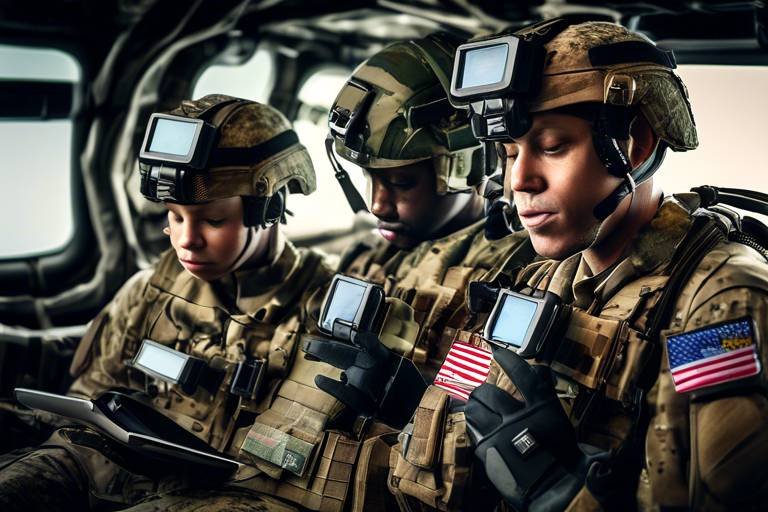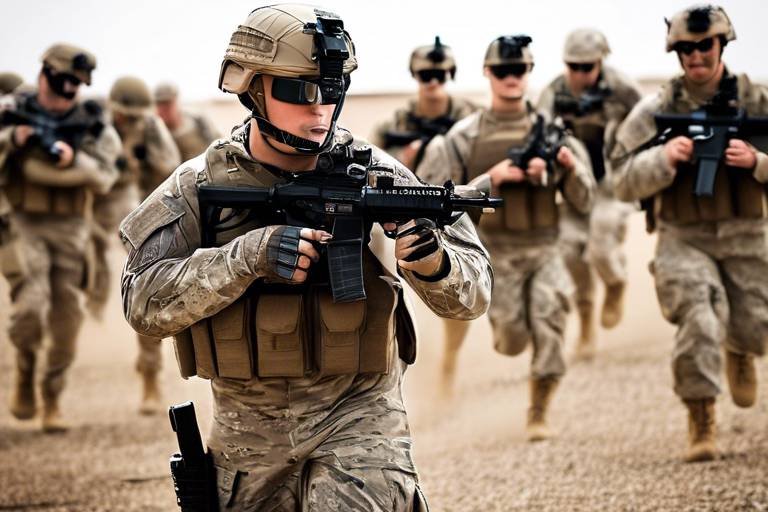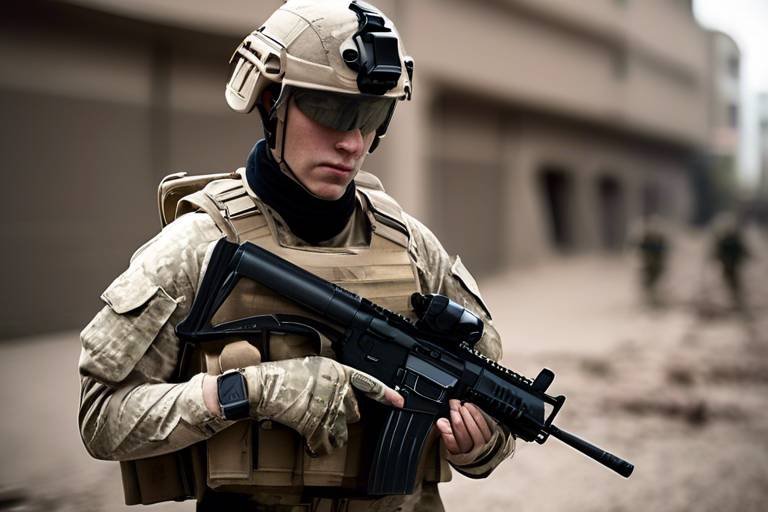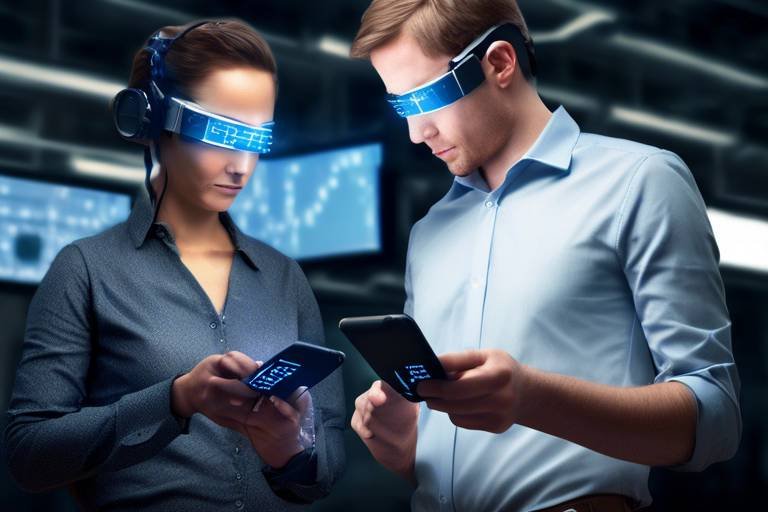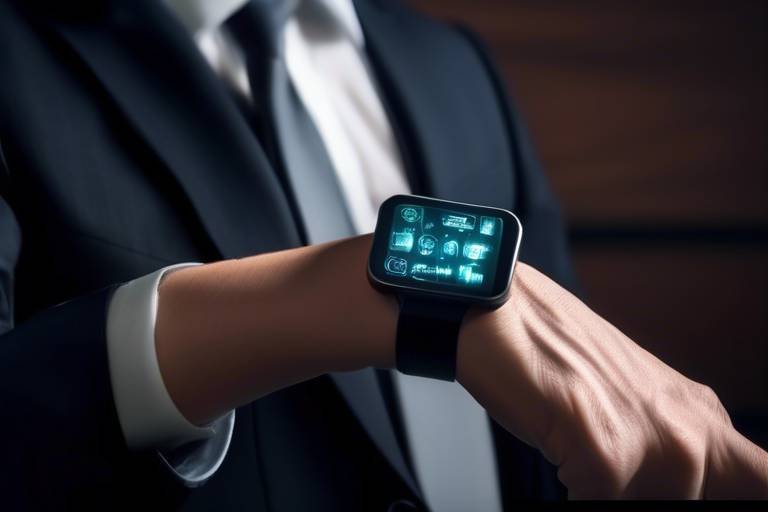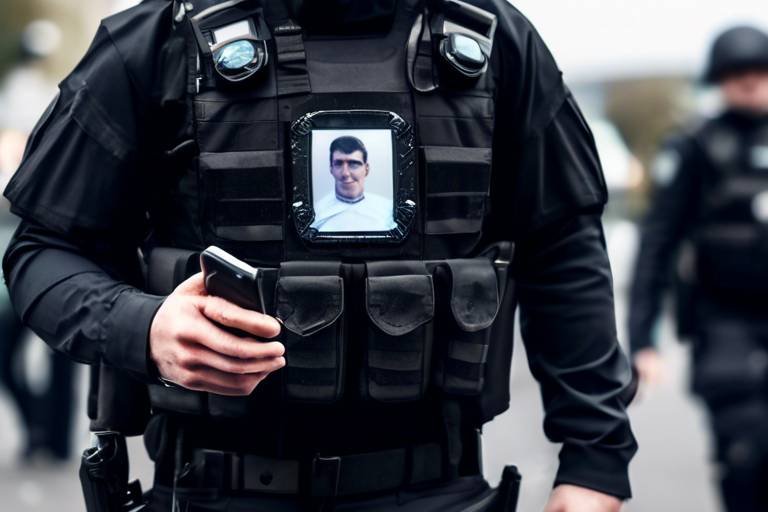How Wearables Are Enhancing Joint Tactical Operations
In today's fast-paced world, where every second counts, wearable technology is revolutionizing the way military and law enforcement agencies conduct joint tactical operations. Imagine being in the field, surrounded by uncertainty, yet having the ability to access critical information right at your fingertips. This is not science fiction; it’s the reality brought forth by wearable devices. These gadgets are not just trendy accessories; they are lifelines that enhance communication, improve situational awareness, and ultimately boost mission effectiveness.
One of the most significant advantages of wearable devices is their ability to facilitate real-time communication among team members. Picture a scenario where team members are scattered across a vast area. In such situations, every second matters, and the ability to share critical information instantly can be the difference between success and failure. Wearables allow for seamless communication, ensuring that everyone is on the same page. This enhanced coordination not only reduces response times but also fosters a sense of unity among team members, which is essential during high-stakes operations.
When you're in the thick of things, having a clear understanding of your surroundings is paramount. Wearable technology plays a crucial role in providing soldiers and officers with vital data about their environment. By integrating various technologies such as GPS, biometrics, and environmental sensors, wearables enhance situational awareness, allowing personnel to make informed decisions in complex scenarios. Imagine being able to see not just where you are, but also the heart rates and stress levels of your teammates, all while navigating a challenging landscape.
The incorporation of GPS within wearables is a game-changer. It allows for precise location tracking, enabling teams to navigate effectively and maintain awareness of each other's positions during operations. This is crucial for safety and strategy. For instance, if one team member encounters danger, others can quickly adjust their positions to provide support or to avoid the threat. The importance of this technology cannot be overstated; it’s like having a map that updates in real-time, guiding you through the chaos.
Real-time location sharing through wearables enhances team coordination significantly. Imagine a scenario where a team is executing a complex maneuver. With location sharing, each member can stay informed about the movements of their colleagues, which is essential for executing joint tactics efficiently and safely. This level of awareness fosters trust and allows for quick adjustments during operations.
Another exciting feature of wearables is geofencing technology. This capability creates virtual boundaries, alerting teams when they enter or exit designated areas. Such alerts ensure compliance with operational parameters, enhancing security and reducing the risk of friendly fire or unintentional breaches. It's like having an invisible fence that keeps everyone safe and focused on the mission.
Wearables equipped with biometric sensors are not just about location; they also track vital signs such as heart rate and stress levels. This information is invaluable, allowing commanders to assess the physical and mental readiness of personnel during high-pressure situations. Imagine being able to see if a team member is approaching their physical limits or if they’re under extreme stress. This data can guide decision-making, ensuring that the right support is provided when it’s needed most.
Beyond real-time applications, wearable technology facilitates extensive data collection. This data can be analyzed to improve operational performance and individual metrics. Think of it as a treasure trove of insights that can lead to better strategies and training protocols for future missions. By harnessing this information, agencies can adapt and evolve, ensuring they remain one step ahead of the challenges they face.
The data collected from wearables during missions can be reviewed to identify strengths and weaknesses. This process fosters continuous improvement and adaptation in tactical approaches for joint operations. It’s like having a coach who reviews game footage with you, highlighting what worked and what didn’t, allowing for refinement of strategies.
Wearable technology also plays a significant role in training simulations. By providing real-time feedback, participants can refine their skills and strategies in a controlled environment before actual deployment. This allows for a more effective training experience, ensuring that personnel are not just prepared but are also confident when the time comes to act.
- What types of wearables are used in tactical operations?
Wearables include smartwatches, fitness trackers, and specialized devices designed for military use. - How do wearables improve safety during operations?
By providing real-time data on team members' locations and vital signs, wearables enhance situational awareness and coordination. - Can wearables be integrated with existing communication systems?
Yes, many wearable devices can be integrated with current communication technologies to streamline operations.
Improved Communication in the Field
In today's fast-paced and unpredictable environments, effective communication is paramount for the success of joint tactical operations. Wearable devices are revolutionizing how military and law enforcement personnel communicate in the field. Imagine a scenario where a team is deployed in a complex urban landscape, where every second counts. With the help of wearable technology, team members can share critical information instantly, enhancing coordination and drastically reducing response times.
Wearable devices, such as smart helmets, body cameras, and tactical vests equipped with communication systems, allow personnel to remain connected without the need for bulky equipment. This is particularly crucial when every ounce of mobility matters. Instead of fumbling with radios or smartphones, officers can communicate hands-free, allowing them to focus on their environment and mission objectives. The seamless integration of voice and data communication within these devices ensures that vital information flows effortlessly among team members, creating a cohesive unit ready to tackle any challenge.
Moreover, the ability to send images and video in real-time transforms the way teams assess situations. For instance, if an officer encounters a suspicious individual, they can quickly share live footage with their command center or fellow officers. This capability not only enhances situational awareness but also allows for rapid decision-making, ensuring that teams can adapt their strategies on-the-fly. The real-time sharing of information empowers personnel to make informed choices, ultimately leading to better outcomes during operations.
To illustrate the impact of improved communication, consider the following table, which outlines the advantages of wearable communication devices:
| Feature | Benefit |
|---|---|
| Hands-free Operation | Allows personnel to maintain situational awareness while communicating. |
| Real-time Data Sharing | Facilitates instant decision-making and enhances team coordination. |
| Live Video Transmission | Improves situational assessment and strategy adaptation. |
| Integrated Communication Systems | Reduces reliance on traditional, bulky communication devices. |
In summary, the integration of wearable technology into joint tactical operations has led to significant improvements in communication. These devices not only enhance the flow of information but also empower personnel to act swiftly and decisively in high-pressure situations. As technology continues to evolve, we can expect even more innovative solutions that will further enhance communication capabilities in the field.
Enhanced Situational Awareness
In the high-stakes world of joint tactical operations, having a clear understanding of the environment is crucial for success. Wearable technology has emerged as a game-changer in this regard, providing soldiers and law enforcement officers with real-time data that enhances their situational awareness. Imagine being in a chaotic environment, where every second counts, and having a device that not only keeps you informed but also helps you make critical decisions on the fly. That’s the power of wearables!
These devices integrate a variety of technologies, including GPS, biometric sensors, and environmental monitors, creating a comprehensive overview of the operational landscape. For instance, soldiers equipped with wearables can receive vital information about their surroundings, such as potential threats, weather conditions, and even the health status of their teammates. This level of awareness is not just beneficial; it can be the difference between mission success and failure.
One of the standout features of wearable technology is the incorporation of GPS. This allows for precise location tracking, enabling teams to navigate effectively through complex terrains. Imagine a team of soldiers on a covert mission in an unfamiliar area. With GPS-enabled wearables, each member can maintain awareness of each other's positions, ensuring that they stay synchronized and can quickly adapt to changing circumstances. This capability is crucial for both safety and strategic planning.
Real-time location sharing is another significant advantage offered by wearable devices. When team members can see each other's movements on a digital map, it enhances coordination and situational awareness. For example, if one officer spots a potential threat, they can instantly alert their teammates, who can then adjust their positions accordingly. This seamless flow of information allows for efficient execution of joint tactics and significantly reduces the risk of friendly fire incidents.
Moreover, wearables equipped with geofencing technology can create virtual boundaries that alert teams when they enter or exit designated areas. This feature is particularly useful in maintaining operational parameters and ensuring compliance with mission objectives. For example, if a team is tasked with securing a specific zone, geofencing can provide real-time alerts if members stray outside their assigned areas, thereby enhancing overall security.
Wearables are not just about location; they also focus on the individual’s well-being. Equipped with biometric sensors, these devices can monitor vital signs like heart rate and stress levels. This data is invaluable for commanders who need to assess the physical and mental readiness of their personnel during high-pressure situations. Imagine a soldier in the heat of battle—being able to gauge their stress levels can help leaders make informed decisions regarding reinforcements or tactical changes.
In summary, wearable technology significantly enhances situational awareness in joint tactical operations by providing real-time data, improving communication, and ensuring personnel safety. As these devices continue to evolve, their potential to transform military and law enforcement operations will only grow, making them an indispensable tool in the field.
- What types of wearables are commonly used in tactical operations?
Common types of wearables include GPS trackers, biometric monitors, communication devices, and environmental sensors.
- How do wearables improve team coordination?
Wearables facilitate real-time location sharing and communication, allowing team members to stay informed about each other’s movements and respond quickly to changing situations.
- Can wearables be used in training simulations?
Yes, wearables are increasingly used in training simulations to provide real-time feedback and improve participants' skills in a controlled environment.
Integration of GPS Technology
The integration of GPS technology into wearable devices has revolutionized the way military and law enforcement personnel operate in the field. Imagine being in a high-pressure situation where every second counts; having precise location tracking at your fingertips can be a game changer. GPS-enabled wearables provide real-time data on the positions of team members, ensuring that everyone is aware of each other’s movements. This level of situational awareness is crucial, especially in complex environments where split-second decisions can mean the difference between success and failure.
Moreover, the ability to navigate effectively is enhanced through GPS integration. Teams can plot their routes and avoid potential hazards, all while receiving live updates on their surroundings. This not only improves operational efficiency but also significantly boosts team safety. In scenarios where visibility is limited or the terrain is challenging, having a reliable GPS system can feel like having a trusted compass guiding you through the fog.
One of the standout features of GPS technology in wearables is real-time location sharing. This function allows team members to see each other’s locations on a digital map, which is particularly beneficial during joint operations. It’s like having a virtual bird’s-eye view of the battlefield, enabling commanders to make informed tactical decisions based on the real-time positions of their personnel. For instance, if a team member is pinned down or needs assistance, others can quickly locate and respond to the situation without delay.
Additionally, the incorporation of geofencing capabilities within these GPS systems adds another layer of security and operational effectiveness. Geofencing creates virtual boundaries that trigger alerts when a team member enters or exits designated areas. This technology not only ensures that personnel adhere to operational parameters but also helps in monitoring compliance during sensitive missions. For example, if a unit is tasked with securing a specific zone, geofencing can notify commanders if any team member strays outside the established perimeter, allowing for immediate corrective action.
In summary, the integration of GPS technology into wearable devices is not just an enhancement; it’s a transformative element that significantly impacts joint tactical operations. By providing precise location tracking, real-time sharing, and geofencing capabilities, these devices empower teams to operate more effectively and safely in dynamic environments. In the ever-evolving landscape of military and law enforcement operations, embracing such technology is not just advantageous—it’s essential.
- How does GPS technology improve team safety?
GPS technology enhances team safety by providing real-time location data, allowing personnel to stay aware of each other’s movements and react quickly to any potential threats. - What is geofencing, and how does it work?
Geofencing uses GPS technology to create virtual boundaries. When a team member enters or exits these boundaries, alerts are triggered, helping to maintain operational compliance. - Can GPS wearables be used in adverse weather conditions?
Yes, most GPS-enabled wearables are designed to function effectively in various weather conditions, ensuring reliable tracking and communication.
Real-time Location Sharing
Imagine being in a high-stakes situation where every second counts. In the world of joint tactical operations, through wearable technology becomes a game changer. This capability allows team members to see each other's precise locations on a digital map, which is crucial for maintaining situational awareness and ensuring safety. No longer do soldiers or officers need to rely on verbal communication or outdated maps; instead, they can leverage the power of live data to make informed decisions.
With real-time location sharing, the dynamics of teamwork shift significantly. For instance, if one member of a tactical team spots a potential threat, they can instantly communicate their location to others, enabling quick reactions and coordinated responses. This is particularly important in complex environments where visibility may be limited. The ability to track where everyone is in relation to one another not only boosts confidence but also enhances the overall effectiveness of the operation.
Furthermore, the integration of this technology is seamless. Wearable devices equipped with GPS and communication tools allow for a user-friendly interface, meaning that even in high-pressure situations, team members can easily access and interpret location data. Here are some key benefits of real-time location sharing:
- Increased Safety: Knowing where everyone is reduces the risk of friendly fire and enhances overall mission safety.
- Improved Coordination: Teams can execute complex maneuvers more effectively, as they can see how their movements align with those of their colleagues.
- Faster Response Times: Immediate awareness of team positions allows for quicker decision-making when situations change rapidly.
Additionally, the technology can be programmed to send alerts if a team member strays outside a designated area, further enhancing operational security. This geofencing capability not only improves coordination but also instills a sense of accountability among team members, as they are constantly aware of their surroundings and each other’s movements.
In conclusion, real-time location sharing through wearables is not just a technological advancement; it’s a vital tool that transforms how military and law enforcement agencies conduct joint operations. By fostering better communication, enhancing situational awareness, and ultimately increasing mission effectiveness, this technology is paving the way for a new era of tactical operations.
- What types of wearables are used in joint tactical operations?
Wearables can include smart helmets, wristbands, and body cameras, all equipped with GPS and communication features.
- How does real-time location sharing improve safety?
It minimizes the risk of friendly fire and ensures that team members are aware of each other’s positions at all times.
- Can real-time location sharing work in areas with poor connectivity?
Many wearables have offline capabilities, allowing them to store data and sync when connectivity is restored.
Geofencing Capabilities
The emergence of geofencing technology within wearable devices has revolutionized how military and law enforcement agencies operate in the field. Imagine having the ability to create invisible boundaries that alert personnel when they enter or exit specific areas—this is precisely what geofencing offers. By leveraging GPS data, geofencing establishes virtual perimeters that enhance operational security and compliance. For instance, if a team is tasked with monitoring a sensitive location, geofencing can trigger alerts to commanders if any personnel inadvertently stray outside designated areas.
This technology not only improves safety but also streamlines coordination during joint tactical operations. Consider a scenario where multiple teams are deployed in a large area; geofencing can help ensure that each unit remains within their assigned zones, thereby reducing the risk of overlap and potential conflict. Moreover, these alerts can be tailored to the mission's needs, allowing for a flexible response based on real-time developments.
In addition to safety and coordination, geofencing capabilities can enhance operational efficiency. By analyzing the data collected from geofencing alerts, commanders can gain insights into movement patterns and operational behaviors. This analysis is crucial for refining strategies and optimizing resource allocation. For example, if a particular area frequently triggers alerts, it may indicate a need for increased surveillance or a reassessment of operational tactics in that region.
To further illustrate the benefits of geofencing technology, consider the following table that highlights its key features and advantages:
| Feature | Advantage |
|---|---|
| Virtual Boundaries | Enhances security by ensuring personnel remain within designated areas. |
| Real-time Alerts | Provides immediate feedback on personnel movements, improving situational awareness. |
| Data Analytics | Facilitates analysis of movement patterns to optimize operational strategies. |
| Customizable Parameters | Allows for tailored alerts based on specific mission requirements. |
In conclusion, the integration of geofencing capabilities in wearables is a game-changer for joint tactical operations. By ensuring compliance with operational parameters and enhancing security, this technology not only protects personnel but also promotes a more streamlined and efficient approach to mission execution. As agencies continue to adopt these advanced tools, the future of tactical operations looks brighter than ever.
- What is geofencing? Geofencing is a technology that creates virtual boundaries using GPS data to monitor movements in specific areas.
- How does geofencing enhance security? By alerting personnel when they enter or exit designated areas, geofencing helps maintain operational compliance and safety.
- Can geofencing be customized for specific missions? Yes, geofencing parameters can be tailored to meet the unique needs of each operation.
- What are the benefits of using geofencing in joint operations? Geofencing improves situational awareness, enhances coordination, and provides valuable data for operational analysis.
Biometric Monitoring
In the heat of joint tactical operations, every second counts, and the ability to monitor the physical and mental state of personnel can be a game-changer. through wearables provides real-time insights into vital signs, such as heart rate, blood pressure, and stress levels. Imagine being able to assess whether a team member is operating at peak performance or if they are on the brink of exhaustion—all without needing to interrupt their focus. This technology acts like a digital lifeline, allowing commanders to make informed decisions based on the physiological data collected from their personnel.
For instance, a sudden spike in heart rate can indicate that an officer is under duress, prompting immediate support. Conversely, consistent monitoring can also highlight individuals who are excelling, enabling leaders to harness their strengths for critical tasks. The integration of biometric sensors into wearables not only enhances operational effectiveness but also prioritizes the well-being of team members, which is essential in high-stress environments.
Moreover, the data gathered from these devices can be invaluable for post-mission analysis. By evaluating biometric trends during operations, military and law enforcement agencies can identify patterns that may not be immediately visible. For example, if a particular operation consistently leads to elevated stress levels among team members, this insight can inform future training and operational adjustments. The ability to adapt based on real-time data is akin to having a tactical edge—one that can mean the difference between mission success and failure.
In addition to monitoring physical health, biometric data can also provide insights into mental resilience. High-stakes situations can take a toll on mental health, and wearables can alert commanders to those who may need psychological support. This proactive approach fosters a culture of care and preparedness, ensuring that all personnel are not only physically fit but also mentally ready to face the challenges of their missions.
Overall, biometric monitoring through wearables is revolutionizing the way joint tactical operations are conducted. It empowers teams to operate more effectively, enhances safety, and promotes a holistic view of personnel readiness. As technology continues to advance, the potential for these devices to improve outcomes in the field is limitless, paving the way for a new era of operational excellence.
- What types of biometric data can wearables track? Wearables can track various types of biometric data, including heart rate, blood pressure, body temperature, and stress levels.
- How does biometric monitoring improve team performance? By providing real-time insights into personnel health, commanders can make informed decisions, allocate resources effectively, and ensure that team members are physically and mentally prepared for their missions.
- Can biometric data be used for training purposes? Yes, data collected from wearables can be analyzed to refine training protocols, ensuring that personnel are better prepared for real-world scenarios.
- Are there privacy concerns with biometric monitoring? While biometric monitoring enhances safety and performance, it is essential to address privacy concerns by ensuring that data is handled securely and ethically.
Data Collection and Analysis
In the realm of joint tactical operations, the ability to collect and analyze data is nothing short of revolutionary. Wearable technology serves as a powerful tool for gathering extensive data, which can be instrumental in assessing operational performance and individual metrics. Imagine having a personal assistant that not only tracks your every move but also provides insights into your performance and well-being. This is precisely what wearables do for military and law enforcement personnel. By collecting data on various parameters during missions, these devices pave the way for informed decision-making and strategic enhancements.
One of the most significant advantages of wearables is their capacity for real-time data collection. These devices continuously monitor and log vital statistics, such as heart rates, movement patterns, and environmental conditions. This data can be invaluable for commanders, as it allows them to gauge the physical and mental states of their personnel in high-pressure situations. For instance, if a soldier's heart rate spikes unexpectedly, it could signal stress or fatigue, prompting immediate intervention. This level of monitoring ensures that teams are not only operationally effective but also physically and mentally prepared for the challenges they face.
Moreover, the data collected through wearables can be utilized for post-mission reviews. After a mission, commanders can analyze the data to pinpoint strengths and weaknesses within their teams. This process of reflection is crucial for continuous improvement. For example, if certain strategies led to higher stress levels or decreased efficiency, adjustments can be made for future operations. The insights gained from data analysis foster a culture of learning and adaptation, ensuring that every mission contributes to the collective knowledge and capability of the team.
Additionally, wearables facilitate training and simulation enhancements. By providing real-time feedback during training exercises, these devices allow participants to refine their skills and strategies in a controlled environment. Imagine being in a virtual reality scenario where your performance metrics are displayed in real-time, guiding you to make better decisions on the fly. This type of immersive training not only builds confidence but also prepares personnel for the unpredictability of real-world operations.
To illustrate the impact of data collection through wearables, consider the following table that highlights key metrics tracked during a typical joint operation:
| Metric | Description | Importance |
|---|---|---|
| Heart Rate | Tracks the physiological response of personnel | Indicates stress levels and physical exertion |
| Location Data | Real-time GPS tracking of team members | Enhances situational awareness and coordination |
| Environmental Conditions | Monitors temperature, humidity, and air quality | Helps assess operational safety and comfort |
| Activity Levels | Measures movement and activity intensity | Assesses physical readiness and fatigue |
In conclusion, the integration of wearable technology in joint tactical operations is a game-changer. It not only enhances communication and situational awareness but also significantly contributes to data collection and analysis. The insights gained from this data empower commanders and personnel alike, ensuring that they are always prepared, informed, and ready to adapt to the dynamic challenges of their missions.
- What types of wearables are used in tactical operations? Wearables can include smart helmets, body cameras, GPS devices, and biometric monitors.
- How does data from wearables improve mission outcomes? Data analysis allows for better decision-making, enhanced training, and improved operational strategies.
- Can wearable technology be used in training exercises? Yes, wearables provide real-time feedback during training, helping personnel improve their skills and readiness.
- What are the privacy concerns associated with wearable technology? Privacy concerns can arise from data collection, but strict protocols and regulations are often in place to protect sensitive information.
Post-Mission Reviews
Post-mission reviews are an essential component of any tactical operation, serving as a crucial feedback mechanism that helps teams analyze their performance and refine their strategies. After a mission, the data collected from wearable devices can be meticulously reviewed to identify both strengths and weaknesses. This process is akin to a sports team watching game footage to understand what worked and what didn't. By examining the metrics gathered during the operation, commanders can gain insights into various aspects, such as communication efficiency, situational awareness, and individual performance.
One of the primary advantages of utilizing wearable technology in post-mission reviews is the ability to compile comprehensive data sets. This data can include:
- Heart rate and stress levels of personnel
- GPS tracking data for movement patterns
- Communication logs between team members
- Environmental conditions during the operation
By analyzing this information, military and law enforcement agencies can pinpoint specific areas for improvement. For example, if data shows that team members experienced high stress levels during particular phases of an operation, commanders can address these concerns through targeted training or adjustments in tactics. Furthermore, this analysis can lead to the development of new strategies that are better suited to the challenges faced in the field.
Moreover, post-mission reviews foster a culture of continuous improvement. Teams are encouraged to engage in open discussions about their experiences, sharing insights and lessons learned. This collaborative approach not only enhances individual skills but also strengthens team cohesion. Just as a well-oiled machine requires regular maintenance, so too do tactical teams need to evaluate and adjust their operations regularly to stay effective and efficient.
To illustrate the impact of post-mission reviews, consider the following table that summarizes key findings from a recent joint tactical operation:
| Metric | Average Value | Action Taken |
|---|---|---|
| Average Heart Rate | 120 bpm | Increased focus on stress management training |
| Communication Delays | 5 seconds | Implemented new communication protocols |
| GPS Positioning Accuracy | 95% | Reviewed GPS device calibration procedures |
In conclusion, post-mission reviews powered by wearable technology are not just about evaluating past performances; they are about paving the way for future successes. By leveraging data-driven insights, military and law enforcement agencies can continuously adapt and improve their tactics, ensuring that they remain one step ahead in the ever-evolving landscape of joint operations.
- What is the primary purpose of post-mission reviews?
Post-mission reviews aim to analyze performance, identify strengths and weaknesses, and foster continuous improvement in tactical operations. - How does wearable technology enhance post-mission reviews?
Wearable technology provides comprehensive data on vital signs, communication, and GPS tracking, which can be analyzed to improve future missions. - What types of data are collected during missions?
Data collected includes heart rate, stress levels, GPS tracking, communication logs, and environmental conditions. - Why is team discussion important in post-mission reviews?
Team discussions encourage sharing of insights and lessons learned, which enhances individual skills and strengthens team cohesion.
Training and Simulation Enhancements
In the ever-evolving landscape of military and law enforcement training, wearable technology emerges as a game-changer, revolutionizing how personnel prepare for real-world scenarios. Imagine stepping into a training environment where every movement, every heartbeat, and every decision is monitored and analyzed in real-time. This is precisely what wearables offer, creating a dynamic and immersive experience that was previously unimaginable.
The integration of wearable devices in training simulations allows instructors to gather valuable data on participants’ performance. For instance, during a simulated operation, wearables can track vital signs, movement patterns, and even stress levels. This data is crucial, as it enables commanders to assess not only the physical capabilities of their team but also their mental resilience under pressure. With this information, training can be tailored to address specific weaknesses, ensuring that every member of the team is mission-ready.
One of the most exciting aspects of wearable technology in training is the ability to provide real-time feedback. Imagine being in the midst of a high-stakes simulation and receiving instant insights about your performance. This immediate feedback loop allows participants to make quick adjustments, enhancing their skills on the fly. For example, if a soldier's heart rate spikes beyond a certain threshold during a stressful scenario, the wearable can alert them to focus on their breathing techniques, thereby promoting better stress management in actual operations.
Moreover, the incorporation of wearables into training simulations creates a more engaging and interactive experience. Participants can be divided into teams, each equipped with wearables that monitor their movements and interactions. This setup not only fosters teamwork but also allows for the analysis of group dynamics during operations. Instructors can later review the data to identify how well teams collaborated and where improvements can be made. This is akin to a sports team reviewing game footage to strategize for their next match—it's all about learning and evolving.
To highlight the impact of wearables in training, consider the following table that summarizes their key benefits:
| Benefit | Description |
|---|---|
| Real-time Feedback | Instant insights on performance to improve skills during training. |
| Data Analysis | Collecting metrics to tailor training programs to individual needs. |
| Enhanced Engagement | Interactive simulations that promote teamwork and collaboration. |
| Stress Management | Monitoring vital signs to teach effective coping strategies. |
As we look to the future, the potential for wearable technology in training and simulations is boundless. With advancements in technology, we can expect even more sophisticated devices that offer deeper insights into performance and readiness. This not only prepares personnel for the challenges they will face but also cultivates a culture of continuous improvement. Just like athletes who constantly refine their techniques, military and law enforcement teams will benefit from a similar approach, ensuring they are always at the top of their game.
- How do wearables improve training simulations?
Wearables provide real-time feedback, track vital signs, and collect data that can be analyzed to enhance training effectiveness. - What types of data can wearables collect during training?
They can monitor heart rate, movement patterns, stress levels, and overall performance metrics. - Can wearables be used in real-world operations?
Yes, the insights gained from training can be directly applied to improve performance in actual missions. - Are wearables customizable for different training scenarios?
Absolutely! Wearables can be tailored to meet the specific needs of various training exercises and environments.
Frequently Asked Questions
- What are wearables in joint tactical operations?
Wearables refer to advanced technology devices that can be worn on the body, such as smartwatches, fitness trackers, and specialized military gear. In joint tactical operations, these devices enhance communication, situational awareness, and overall mission effectiveness for military and law enforcement agencies.
- How do wearables improve communication in the field?
Wearable devices enable real-time communication among team members, allowing for instant sharing of critical information. This capability enhances coordination and significantly reduces response times during joint operations, ensuring everyone is on the same page.
- What role does GPS technology play in wearables?
GPS technology integrated into wearables allows for precise location tracking. This feature is crucial for teams to navigate effectively and maintain awareness of each other's positions, enhancing safety and strategic planning during operations.
- Can wearables monitor biometric data?
Yes! Wearables equipped with biometric sensors can track vital signs like heart rate and stress levels. This information helps commanders assess the physical and mental readiness of personnel, especially in high-pressure situations.
- How does data collection from wearables benefit future missions?
The extensive data collected from wearables during missions can be analyzed to identify strengths and weaknesses. This post-mission review fosters continuous improvement and helps refine strategies and training protocols for future operations.
- What are geofencing capabilities in wearables?
Geofencing technology allows wearables to create virtual boundaries. Teams receive alerts when they enter or exit designated areas, ensuring compliance with operational parameters and enhancing overall security during missions.
- How do wearables enhance training simulations?
Wearable technology provides real-time feedback during training simulations, enabling participants to refine their skills and strategies in a controlled environment. This preparation is essential before actual deployment in joint tactical operations.



